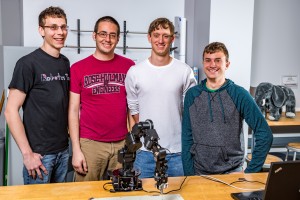November 23, 2015 – Case Study 1:
Rose-Hulman Institute of Technology Students to Compete in RobotArt 2016
Students compete for a portion of $100,000 in cash awards from RobotArt 2016 contest by creating a robot that uses physical brushes to paint a work of art.
Students at Rose–Hulman Institute of Technology are hoping to create robotic art that wins up to $40,000 out of $100,000 in cash awards available to be donated to schools and universities in the first annual International RobotArt 2016 competition.
“We knew that we could use the school’s lab robots, and we couldn’t wait to see what we could do with them,” said Gunnar Horve, a senior majoring in mechanical engineering with a minor in robotics from Clinton, IL, and the student team leader for Rose-Hulman’s Team “Bob Ross.” Gunnar recruited his friend and classmate, Zach Dougherty, also majoring in mechanical engineering with a minor in robotics, from Barboursville, WV. “All I had to do was tell Zach about the contest, and that it didn’t cost anything to enter, and he was in,“ Gunnar said.
The students named their team to honor Bob Ross, an artist who teaches amateur artists how to paint at https://www.bobross.com/. The next step was for the students to register their team name and contact information to open their official entry in RobotArt 2016 at http://robotart.org/register-team/.
“We hope to be able to reproduce an image process with a robot that can physically take a brush, and put it to canvas to create works of art,” Gunnar said.
Together, Gunnar and Zach built their first prototype which was able to draw simple shapes. To extend the prototype and to have more fun, they decided to recruit other students to their team, adding Luke Drong, a senior majoring in mechanical engineering with a minor in robotics from Lockport, IL, and Josh Crook, a senior mechanical engineering major with a minor in robotics from Martinsville, IN. “We didn’t have to convince Luke or Josh to join us; we simply had to tell them about this contest with an interesting challenge, few competitors, and no entry fee, and they were in,“ said Gunnar.
 From left to right: Gunnar Horve, Josh Crook, Zach Dougherty, and Luke Drong.
From left to right: Gunnar Horve, Josh Crook, Zach Dougherty, and Luke Drong.
Together the four mapped out a plan to spend about 10 hours weekly together in the Rose-Hulman lab, working on control software, brush simulation, and hardware to house paints. Their strategy was to first to get the robot to be able replicate existing art and then worry about having it get creative. This meant they would start with software to figure out how to paint a region with just a single color and then figure out how to divide an existing image into regions. The following two videos show both steps.
The following video shows the team’s first proof-of-concept to get their robot arm to paint a region using a foam brush.
The team approached mechanical engineering professor, Dr. David Fisher, to be the team’s faculty mentor. They asked Dr. Fisher if their team entry in the RobotArt 2016 competition could qualify as their Senior Capstone Design Project, so that they could receive school credit and more time in the lab. Dr. Fisher approved. The RobotArt 2016 project is being rewarded with classroom credit as a part of Rose-Hulman’s Multidisciplinary Robotics Program, where students can tailor credits in robotics competition to their own interests and degree program.
“There’s no risk in the students’ competing in Robotart2016, only potential rewards for them and for Rose-Hulman,” Dr. Fisher said. “And, the potential reward of $30,000 or $40,000 to our robotics program is not negligible. We’d use it for more robots and learning opportunities, so the next generation of students will have more.”
Rewards for Students:
“Regardless of whether we win or not, we are having fun, and it’s definitely something to put on my resume.”
— Gunnar Horve, student team leader for team Bob Ross, Rose-Hulman Institute of Technology.
The students on Team Bob Ross are already reaping the rewards of their work; Several of the team members have had job interviews at a robotics company, where they found that recruiters are very interested in hearing about their work on their entry into RobotArt 2016.
“It’s definitely something to put on my resume,” said Horve.
Following a sabbatical at Google and multiple summers as a consultant at Apple Inc., Dr. Fisher understands what recruiters for major employers of engineering and robotics students are looking for. “Competitions like RobotArt 2016 are a differentiator for students when they are interviewing for the job of their dreams,” said Dr. Fisher. “When there are 100 candidates with the same degree and GPA applying for the same position, what students really need are projects like this to showcase what they can do.”
Rewards for Educators:
“…the potential donation of $30,000 or $40,000 to our robotics program is not negligible. We’d use it for more robots and learning opportunities, so the next generation of students will have more.”
— David Fisher, PhD & associate professor of mechanical engineering, Rose-Hulman Institute of Technology
Educators are not required to do anything at all for their students to compete. Students are simply asked to name a faculty mentor as part of the short, team registration.
“I really haven’t had to do anything; these students are already strong programmers and mechanical engineers,” said Dr. Fisher. “This is low-risk opportunity with high-reward potential for both the students and the school. RobotArt 2016 would be perfect for any masters’ thesis, but it could also be appropriate for undergraduate coursework.”
Faculty and school administrators are also encouraged to sign-up at http://robotart.org/register-team/, so that you can ear-mark which department will be the recipient of donated funds if the student team from your accredited school wins the competition in one or more categories. To get your student team started, we suggest:
- Register yourself/the school that you represent at http://www.robotart.org/register-team. This will ensure that the donation goes to your school’s particular class, lab, school or robotics club or program.
- Invite individual students or your art/engineering/robotics class to compete today, with a simple email to asking them to participate. Contact us at http://robotart.org/about-us/, and we can provide you with a template email to send to your students.
- Forward this email to your robotic clubs, teaching professors, marketing, etc, to encourage participation. The more student teams from your school that participate, the more opportunities to win a cash award to support your school or robotics program.
About Rose-Hulman Institute of Technology:
Rose–Hulman Institute of Technology is a private college specializing in science, engineering, and mathematics education. It has been ranked the nation’s number one institution for undergraduate engineering for 17 consecutive years in U.S. News and World Report’s annual college guide.
